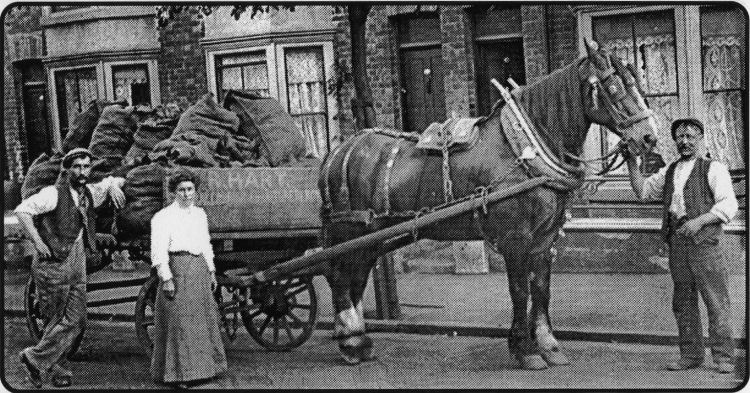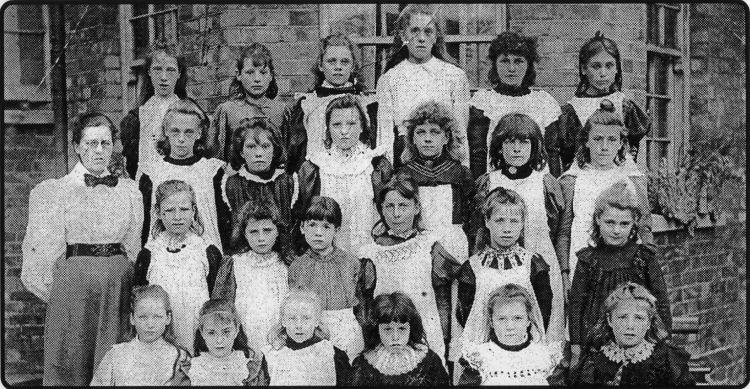
Published 4 April 2002


Family
THIS interesting old photograph of Folkestone revives memories of
fascinating pictures I have seen of the sailing ships which used to
discharge cargoes at Folkestone harbour. A row of these vessels, lining up
with their long bowsprits over the quayside made a grand sight.
Some of the vessels brought cargoes of sawn timber from Scandinavia, others
were often coastal vessels laden with coal.
The coal cart picture was shown to me by Eric Hart, of Chart Road,
Folkestone, who has a fund of memories of the town and is a popular speaker
on the subject of Old Folkestone.
Standing by the horse is Eric's grandfather Richard Cullen Hart, who
operated his business from a yard in Park Street, now called Jesmond Street,
which was behind the cameraman. Eric's grandmother and a roundsman stand by
the cart.
Richard built up a big business in the town and raised a large family, with
12 children, all brought up in the old family home, which was at 43
Blackbull Road.
Eric's father Eddie was one of the 12 children. He worked for 38 years for
the furniture removal firm of Thompsons.
"My father used to have to miss school sometimes when the colliers came in.
That was when he was around 10 or 11, and he used to help in the work of
bagging up the loose coal from the ships.
"His job was to hold the sacks while men shovelled the coal into them. It
was hard work for a lad and he had the scars on his hands for years
afterwards to prove it!" said Eric.
A sad incident he recalls in connection with the
colliers unloading at the harbour concerns a horse and cart which was backed
up to the quayside just in board of the Swingbridge, when suddenly there was
a loud noise from the ship that was discharging its cargo.
“The horse reared up, went backwards and both the horse and cart plunged
into the water. Sadly, of course, the horse was dragged down and drowned."
Eric believes the steam vessel could have been the Hove, bringing coking
coal for the Folkestone Gas Company.
By a strange coincidence I was recently shown two old pictures taken in
Folkestone harbour, possibly around 1900, showing local seamen who worked on
the sailing colliers bringing coal to the port. Both of the deck scene
photos, shown to me by Ray Bryson, of Clarendon Road, Dover, feature among
the seamen Ray's favourite Uncle Ted Andrews, who married his father's
sister.
Ted is thought to have been the first or second mate of the boat. Ted later
worked on local tugs and, in the last few years before retiring, became
foreman flagman working with the seafront coal and oil tanker trains which
steamed along Dover seafront. His task - to walk in front holding a red flag
to warn of the locomotive's approach.
A much earlier photograph Eric brought in to show me, of around 1902, is the
picture, bottom right, of class three, with a teacher, at Sidney Street
girls school - now George Spurgen School. The youngsters are pictured
outside the Head's study.
"My mother, Alice Jane Hart, is first on the left in the front row. She was
about ten years old. The only other name I have is Sally Quaife, mother of
Bob Quaife, the well known hairdresser. She is third from the left in the
second row from the front."
IT IS always satisfying to hear a Memories feature has created a lot of
interest, particularly when an article has helped find information a reader
was seeking or, as in the case of Yvette Fassbender, of Stade Street, Hythe,
has put her in touch with an old friend. Yvette tells me she has got in
touch with Betty, the daughter of Betty Dugdale who was one of the people
with the helmeted diver pictured recently in Memories. Yvette and young
Betty went to the same school in Exeter 63 years ago!
 |
Open tennis tournament planned for Folkestone
<* QAQCORPORAL Morris Carpenter, son of JLS/U& Councillor Carpenter, was
welcomed back In town after 13 months arduous service with the 42nd
Company Imperial Yeomanry in Africa, during which he was Involved In the
fighting when Colonel Benson was killed. With the assistance of the Lawn
Tennis Association of England an open tennis tournament was planned by
manager Mr H.W. Rowland, for mid-summer, on the well tended lawn tennis
courts of the Pleasure Gardens Theatre. The Herald published a news
photograph, rare in a weekly newspaper a century ago, of one of the old
Romney Marsh “Lookers” of the hunting fraternity mounted on horseback.
The framed picture was presented at a Lookers dinner at the Ship at
Dymchurch, to John Jones, of Dymchurch, to mark his 40 years Involvement
with hare coursing, hunting and shooting, of which he was the accepted
leader. The long report Included a list of names of those who subscribed
to the cost of the portrait. Felix noted the passing of Mr Marsh, aged
92, the former "travelling shoemaker of the then fishing village of
Folkestone, of 70 or more years ago," as well as Newington, Cherlton and
Sandgate.
|
Elham-born Test cricket star honoured by fans
<|QCO MAYORS and mayoresses of four .L90^Cinque Ports towns were guests
of Munstereifel's Burgomaster Herr A Frlnz In Germany over Easter,
visiting Cologne, Bonn, Coblenz and Dusseldorf. Munsterelfel, their
base, was about the same size as Hythe, said Speaker of the Cinque
Ports, Alderman J.A. Wiles, of New Romney who was instrumental in
getting the invitation to Munstereifel. Promising Kent and England
cricketer Les Ames, a native of Elham, was prosented by MP Brigadier H.R.
Mackeson with a handsome silver fruit dish from people of the village
and local sportsmen, to mark his cricket achievements, particularly In
India. The event was attended by his father Harold Ames, himself no mean
player. Harold, a left arm spinner, had a proud record in cricket,
Including the remarkable achievement of performing a hat-trick twice In
one innings. Four lofty radar station pylons made an unusual backdrop
for a Romney Marsh Hunt point-to-point meeting near Brookland attended
by thousands of racing fans. The Herald marked the anniversary of the
death of William Harvey, a Harvey Grammar old boy. with a lengthy
article about him. extending to several columns of a broadsheet
newspaper.
|
Top firms to submit plans to furnish the Leas Cliff Hall
«< 00*7 VICAR of Whitstable for 14 years the Revd I Hyla Holden was
inducted as the new Vicar of Folkestone by the Bishop of Dover and the
Archdeacon of Canterbury. Among those there to wish him well was the
retiring minister Canon P. Tindall. A new Saltwood Cricket Club wjs
formed at a meeting at the Lad's Club, with the prospcct of the support
of lower brewer Alfred Leney of the old Phoenix Brewery, in Dover and
the haniis-on voluntary expertise in preparing and maintaining the
wicket of Mr A Pegram. The Council decided to seek proposals for the
decoration of the newly completed Leas Cliff Hall from Libertys, Waring
& Gillow, and Hamptons Ltd. ail of London, as well as local firms. A
sub-committee was to meet those interested to show them round and
indicate what each room was to be used for. No limit on expenditure had
so far been fixed. There were some dissenting voices when the time came
to approve a tender of £6,000 for a chapel foi building a new town
cemetery. One councillor protested it would be like a cathedral compared
with the one In Cheriton Road cemetery which cost about £1.000. A
Sandgate resident warned against use of shingle from the beach to build
otherwise welcome new homes, pointing out the danger of further urosion.
|
Town must watch its image warns the Herald’s editor
•f Q77THE EDITOR was warning that although X? I I Folkestone had some
great assets there were neglected areas which harmed the fashionable
resort Image of the town. He pointed to old narrow streets, which
appeared to have been forgotten, of crumbling cliffs and seafront, which
threatened property, of a confusing one-way traffic system which might
encourage shoppers to go elsewhere, and of the dog dirt menace. The
message was, pay more attention to detail! One of Folkestone's oldest
hotels celebrated its Golden Jubilee, with the original family still at
the helm, said the Herald. When the late Herbert Rutherford loft his job
as a chef at the Metropole Hotel and took over a boarding house In
Langhorne Gardens, which became the Windsor Hotel, the town was still
ranked as a highly fashionable resort. In 1926 when the hotel opened on
Christmas Day there were more titles than credit card holders among
crowds thronging the Leas. Owner by 1977 was Herbert's son Graham.
Herbert's widow Dorothy recalled how, back in the early days friends had
warned about the extravagance of installing phones and vacuum cleaners,
let alone a lift and an intercom systeml She also told how, after the
hotel had been used In wartime by the Army it was left without doors or
windows! Another hotel the family owned was destroyed In a cross-Channel
shelling attack. |
|



